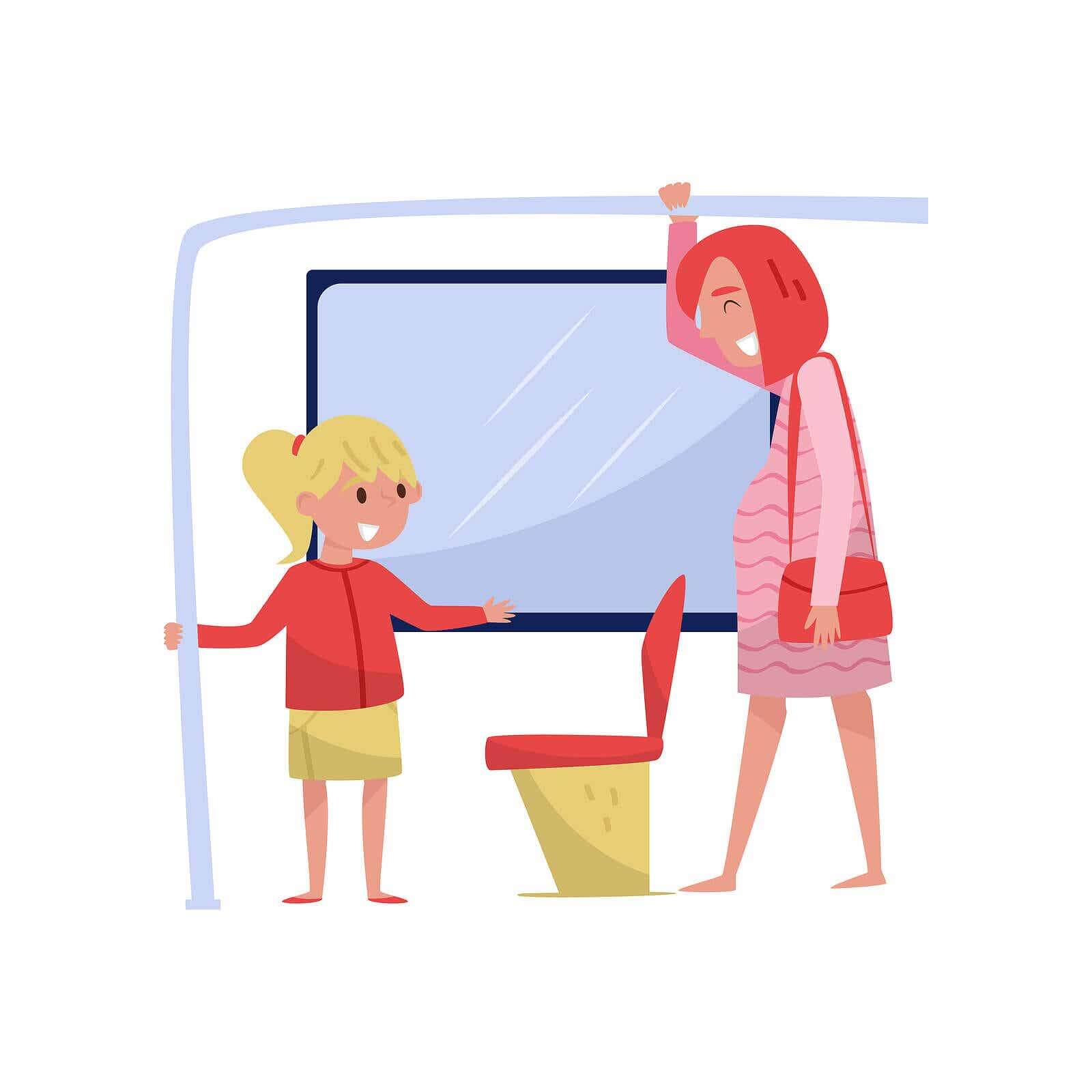Games to Teach Good Manners to Children

Knowing and practicing rules of courtesy and politeness allows people to get along better with others in different contexts and situations. Therefore, to teach good manners to children is to provide them with tools so that, as they grow up, they can behave better in different environments.
After all, aren’t good manners tell you a lot about a person? Often, they can make a world of difference when it comes to work, study, and social opportunities. So, with that in mind, in the following article, we’ll tell you how to teach good manners to children. But first…
What are good manners?
Good manners refer to rules, norms, and codes of conduct institutionalized in each society. They’re a way to show education and respect towards other people. Therefore, good manners allow us to relate to and improve coexistence with people through attitudes or behaviors such as greeting correctly, saying please, thank you, and sorry, offering help, being polite, and cooperating with others.
As we’ve said, good manners vary according to different societies and have a lot to do with their culture and customs. What’s more, they’ve also changed and evolved over time according to historical circumstances.
Therefore, to teach good manners to children, we must also help them understand that they’re not the same everywhere, in all circumstances, or with all people.

What’s indisputable, however, is that courtesy and good manners are important in building relationships with others. And it’s essential that we teach good manners both in the family and in the school environment, because they are ways of showing consideration and appreciation for other people. And because, in addition, they help people us to make a good impression in any setting, both formal and informal.
“Good manners are the flower of humanity. He who is not polite enough is not human enough.”
-Petrus Jacobus Joubert-
Can we teach good manners to children through play?
The answer to this question is yes! As with everything that’s taught to young children, if it’s through play, then it’s much more effective. For children, play’s a very good didactic strategy and has a fundamental value as a learning tool.
Through play, children can learn rules and behaviors of courtesy and kindness, and thus develop and internalize the habit of acting and behaving with good manners.
Therefore, below, we want to suggest several fun games that can be used both at home and at school so that the young children, little by little, can learn some basic rules of politeness.
Playing snack games in order to teach children good manners
A great idea is for parents to organize an afternoon with friends and take advantage of this opportunity to make a delicious snack in which the objective is to learn to eat correctly.
This way, all the little diners will be able to enjoy a delicious cake and a good chocolate or vanilla milkshake, as long as they respect the following rules:
- Don’t rest your elbows on the table while eating and stay seated with your back straight.
- Chew each bite well, eat with your mouth closed and don’t talk with your mouth full of food.
- Take your napkin, place it on your lap, and use it several times during snack time to wipe both your mouth and hands.
- Talk with the other children in a calm manner, without shouting or interrupting others.
Play turn-taking and manners cards
An interesting activity is to hand out cards with pictures of children with good and bad manners or with phrases about good and bad manners. And, at the same time, also hand out cards with numbers, which will be the ones that will give the children the turn to speak.
Therefore, according to the number that’s been randomly assigned to each child, they’ll have to talk about what they see or what they read on the manners card.
The idea is that, through this activity, children can express their opinions and talk about good manners, and also exercise patience and respect for each other’s words while waiting for their own turn to speak.
Fun-filled stories to teach good manners to children
The educational value of stories in teaching children is indisputable. With a story, children learn values, they learn about their emotions, about the world, animals, and nature, and they can also learn about manners.
In this sense, selecting stories that deal with using good manners can be a wonderful way for children to learn them.
Teach good manners through singing and dancing
An activity whose objective is to put music and rhythm to phrases about good manners can be a fun strategy for children. They’ll not only learn good manners, but they’ll also develop their memory and musical skills.
For example, children can be invited to “rap” statements such as: “How cool it is to say you please and thank yous every day” or other phrases that you can come up with together.

The good manners puppets
Finally, something that children like a lot is playing with puppets and, if they’re characters they know and love, then even better.
So, both at school and at home, you can make some charming friends out of old clothes and recycled materials and create stories around superhero puppets who fight for good manners in all sorts of places. For example, you can create the following scenes:
- A bus, with the mission to explain and convince younger people to give up their seats to older people and pregnant women. Or people with disabilities.
- In the street, parks, and schools, with the mission to remind everyone not to litter anywhere, but to look for the appropriate containers to throw and recycle their garbage.
We hope that you’ll soon put into practice these games to teach good manners to children with your own little ones. You’ll have a great time as they learn!
Knowing and practicing rules of courtesy and politeness allows people to get along better with others in different contexts and situations. Therefore, to teach good manners to children is to provide them with tools so that, as they grow up, they can behave better in different environments.
After all, aren’t good manners tell you a lot about a person? Often, they can make a world of difference when it comes to work, study, and social opportunities. So, with that in mind, in the following article, we’ll tell you how to teach good manners to children. But first…
What are good manners?
Good manners refer to rules, norms, and codes of conduct institutionalized in each society. They’re a way to show education and respect towards other people. Therefore, good manners allow us to relate to and improve coexistence with people through attitudes or behaviors such as greeting correctly, saying please, thank you, and sorry, offering help, being polite, and cooperating with others.
As we’ve said, good manners vary according to different societies and have a lot to do with their culture and customs. What’s more, they’ve also changed and evolved over time according to historical circumstances.
Therefore, to teach good manners to children, we must also help them understand that they’re not the same everywhere, in all circumstances, or with all people.

What’s indisputable, however, is that courtesy and good manners are important in building relationships with others. And it’s essential that we teach good manners both in the family and in the school environment, because they are ways of showing consideration and appreciation for other people. And because, in addition, they help people us to make a good impression in any setting, both formal and informal.
“Good manners are the flower of humanity. He who is not polite enough is not human enough.”
-Petrus Jacobus Joubert-
Can we teach good manners to children through play?
The answer to this question is yes! As with everything that’s taught to young children, if it’s through play, then it’s much more effective. For children, play’s a very good didactic strategy and has a fundamental value as a learning tool.
Through play, children can learn rules and behaviors of courtesy and kindness, and thus develop and internalize the habit of acting and behaving with good manners.
Therefore, below, we want to suggest several fun games that can be used both at home and at school so that the young children, little by little, can learn some basic rules of politeness.
Playing snack games in order to teach children good manners
A great idea is for parents to organize an afternoon with friends and take advantage of this opportunity to make a delicious snack in which the objective is to learn to eat correctly.
This way, all the little diners will be able to enjoy a delicious cake and a good chocolate or vanilla milkshake, as long as they respect the following rules:
- Don’t rest your elbows on the table while eating and stay seated with your back straight.
- Chew each bite well, eat with your mouth closed and don’t talk with your mouth full of food.
- Take your napkin, place it on your lap, and use it several times during snack time to wipe both your mouth and hands.
- Talk with the other children in a calm manner, without shouting or interrupting others.
Play turn-taking and manners cards
An interesting activity is to hand out cards with pictures of children with good and bad manners or with phrases about good and bad manners. And, at the same time, also hand out cards with numbers, which will be the ones that will give the children the turn to speak.
Therefore, according to the number that’s been randomly assigned to each child, they’ll have to talk about what they see or what they read on the manners card.
The idea is that, through this activity, children can express their opinions and talk about good manners, and also exercise patience and respect for each other’s words while waiting for their own turn to speak.
Fun-filled stories to teach good manners to children
The educational value of stories in teaching children is indisputable. With a story, children learn values, they learn about their emotions, about the world, animals, and nature, and they can also learn about manners.
In this sense, selecting stories that deal with using good manners can be a wonderful way for children to learn them.
Teach good manners through singing and dancing
An activity whose objective is to put music and rhythm to phrases about good manners can be a fun strategy for children. They’ll not only learn good manners, but they’ll also develop their memory and musical skills.
For example, children can be invited to “rap” statements such as: “How cool it is to say you please and thank yous every day” or other phrases that you can come up with together.

The good manners puppets
Finally, something that children like a lot is playing with puppets and, if they’re characters they know and love, then even better.
So, both at school and at home, you can make some charming friends out of old clothes and recycled materials and create stories around superhero puppets who fight for good manners in all sorts of places. For example, you can create the following scenes:
- A bus, with the mission to explain and convince younger people to give up their seats to older people and pregnant women. Or people with disabilities.
- In the street, parks, and schools, with the mission to remind everyone not to litter anywhere, but to look for the appropriate containers to throw and recycle their garbage.
We hope that you’ll soon put into practice these games to teach good manners to children with your own little ones. You’ll have a great time as they learn!
All cited sources were thoroughly reviewed by our team to ensure their quality, reliability, currency, and validity. The bibliography of this article was considered reliable and of academic or scientific accuracy.
- Bruner, J. (1983). Juego, pensamiento y lenguaje. Revista In-fan-cia Educar de 0 a, 6(6), 4-10. https://www.observatoriodelainfancia.es/ficherosoia/documentos/1742_d_juego_pensamiento_lenguaje.pdf
- Leyva Garzón, A. (2011). El juego como estrategia didáctica en la educación infantil. Recuperado de https://repository.javeriana.edu.co/bitstream/handle/10554/6693/tesis165.pdf?sequence=1&isAllowed=y
- Mafla Papel, B. A. (2016). Dinámicas grupales para fomentar normas de urbanidad y cortesía en los niños y niñas de primer año de Educación Básica de la Escuela Ana Luisa Leoro de la ciudad de Ibarra, en el año lectivo 2015-2016 (Bachelor’s thesis). Recuperado de http://repositorio.utn.edu.ec/bitstream/123456789/5765/1/05%20FECYT%202992%20TRABAJO%20DE%20GRADO.pdf
- Ordóñez Solórzano, M. I. (2013). Aplicación permanente de normas de urbanidad y buenos modales en la convivencia diaria de estudiantes, maestros y padres de familia del jardín de infantes nueva Jerusalén (Bachelor’s thesis, Guayaquil: ULVR, 2013.). Recuperado de http://repositorio.ulvr.edu.ec/bitstream/44000/786/1/T-ULVR-0780.pdf
This text is provided for informational purposes only and does not replace consultation with a professional. If in doubt, consult your specialist.








